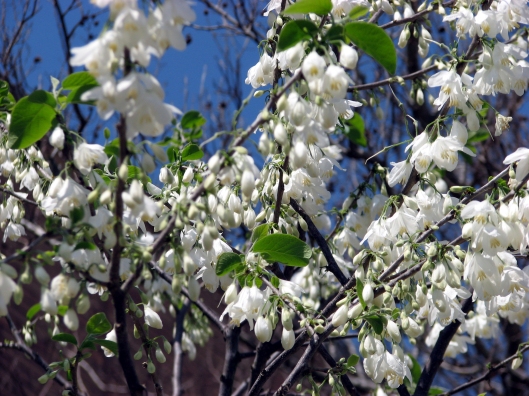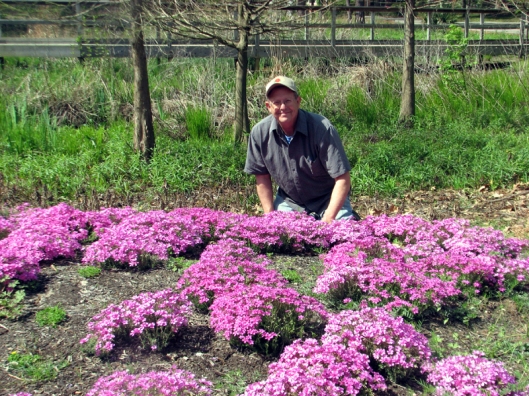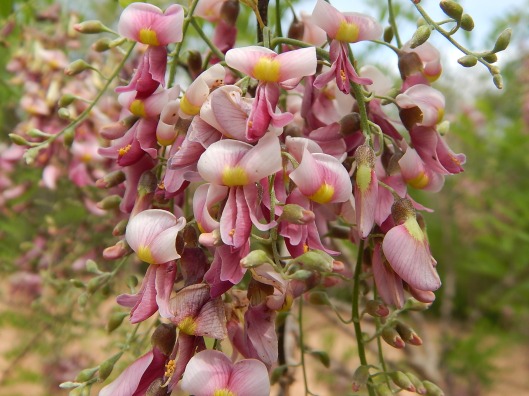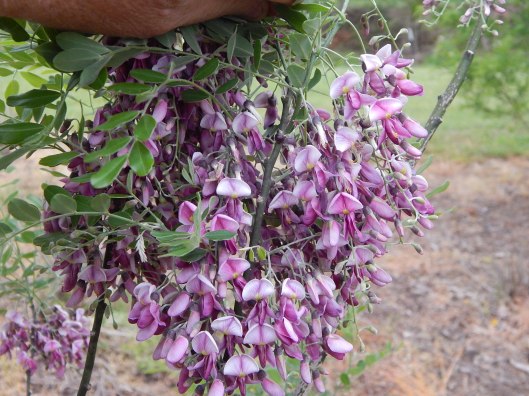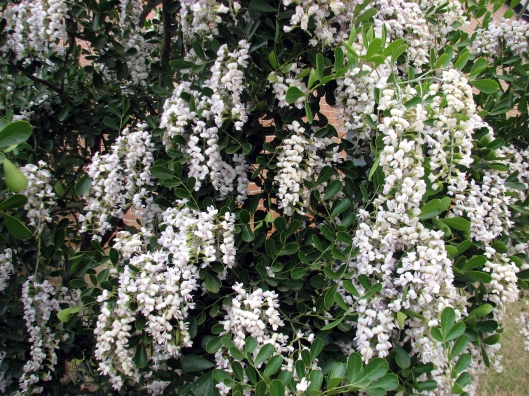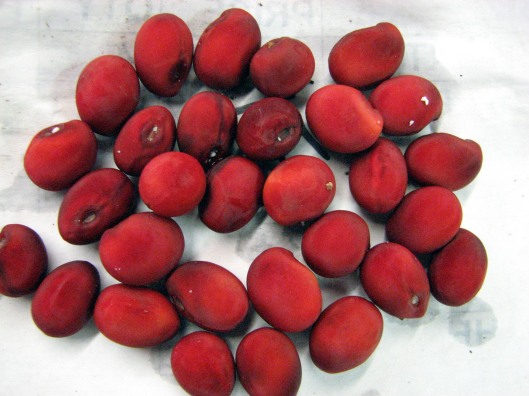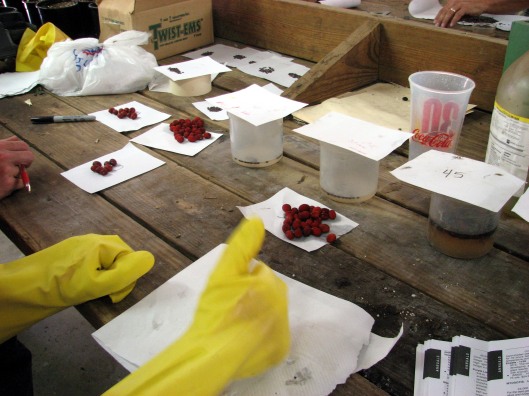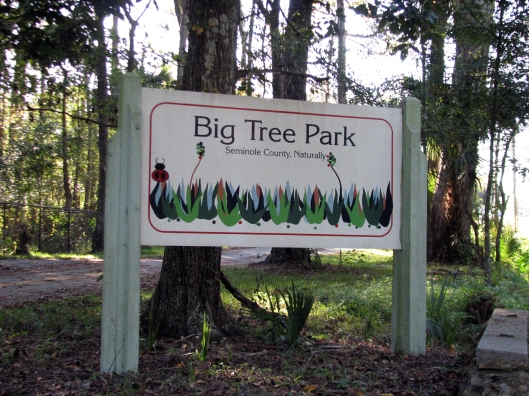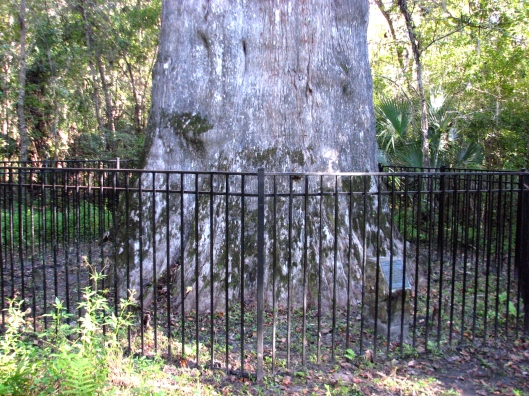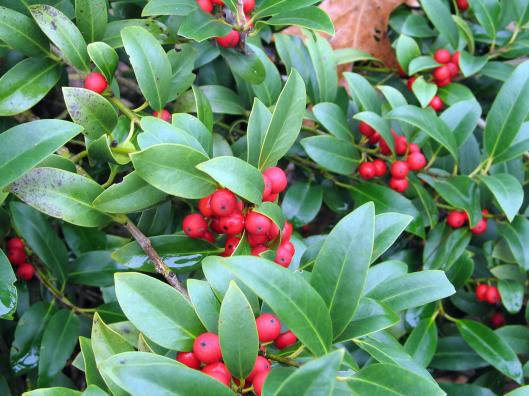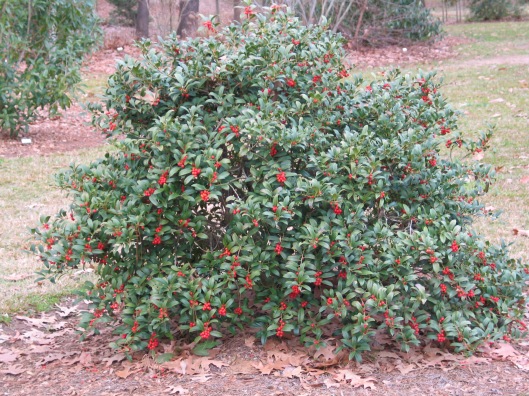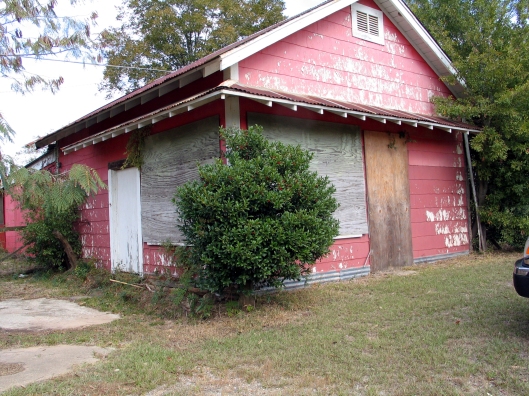This is a modern plant. Taxodium X ‘LaNana’ has been tested far and wide in the USA under the selection number T406. It’s a good one. With genetics flowing from Taxodiums in Mexico and the USA, bred and selected in China, and now back home in the USA, there’s much to think about.
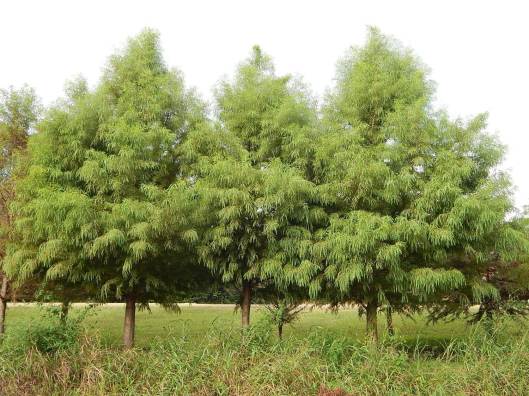
Taxodium ‘LaNana’ (AKA T406) along the banks of LaNana Creek.
I can remember standing in the Nanjing Botanical Garden with my friend and colleague Professor Yin Yunlong in 2001 and he was providing me with my first exposure to the controlled crosses of Bald and Montezuma cypress in the Nanjing Botanical Garden. It had the name Z302 with the Z standing for Zhongshanshan, which memorializes the tree for the Father of Chin Sung Yat-Sen born in 1866. There are now many Taxodium hybrids in China and they are all the result of a Taxodium Improvement Program at Nanjing Botanical Garden, Nanjing, China. While baldcypress are North American, the Chinese have exploited this genus since the early 1900s. As part of a Taxodium improvement program, NBG scientists have produces several lines of Taxodium hybrids. The superior clones have been multiplied by cutting propagation and are planted in the millions in SE China, mostly as roadside forests, but also in wetland restoration projects, as windbreak forests along the inland side of coastal dikes, and as part of canal and river streamside management zones. The clones are primarily the result of controlled crosses of two Taxodium genotypes: Bald cypress (Taxodium distichum var. distichum) (BC) and Montezuma cypress of Mexico and the tip of Texas (Taxodium distichum var. mexicanum) (MC). Pond cypress (Taxodium distichum var. imbricarium) has been utilized in crosses but few selections made (T102 is the exception). The ranges of bald, pond and Montezuma cypress is illustrated in Figure 1.
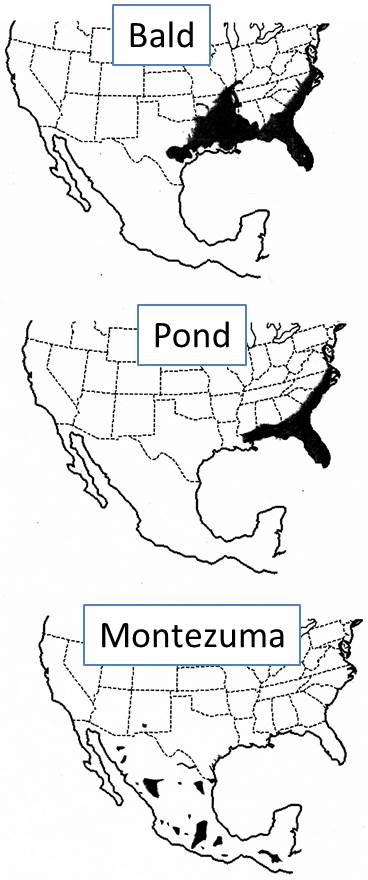
Fig. 1. Range map of the three Taxodium genotypes
A LITTLE HISTORY: In China in 1988, clones Z302 – (a BC X MC F1 hybrid), Z401 (PC X MC), and Z202 (PC X BC) were selected in China primarily for growth rate and tolerance to alkaline and salt-rich coastal floodplains. I came to learn that Z stands for Zhongshanshan, a name that memorializes Sun Yat-Sen, the Father of China, and the word tree. For reasons I can’t remember, I changed that to Z to a T, for the word “tree”, I guess. T302 is recommended in China for soils with pH 8.0~8.5 and salt concentrations <.2%. Other attributes of T302 included 159% faster growth than BC, good columnar form, longer foliage retention in fall and early winter, and no knees. T302 has been in the USA since January 2002 and is currently under evaluation in over 30 locations in southern USA. The clone was named ‘Nanjing Beauty’ in 2004 as a cooperative introduction of the SFA Mast Arboretum and Nanjing Botanical Garden. After many years, the clone can be found in many gardens but the authors conclusion is that this introduction carries a fatal flaw. If not pruned during its early life, the tree is multi-leader and limbs are prone to narrow crotch angles and can break out in winds. In China, trees are cut back dramatically to the leader which forces many branches and a columnar form is created. Properly pruned in its youth, it’s a fine tree. It’s taken me years to figure this out. Professor Yin has reminded me many times that parents train their children, so it is with this tree. He also said that good children come from good parents. Some might argue that.
In March 2005, the SFA Mast Arboretum received two new clones from China. T140 and T27 are considered more evergreen than T302 and both demonstrate strong salt tolerance. The clones were selected from a field population of T302 X TM – with strong TM characteristics and improvements in growth rate, salt tolerance, form and vigor. T140 grows faster than T27, which produces a wider profile. The foundation of the most recent selections comes originally from crosses made by Professor Chen and Liu in 1992 at the Nanjing Botanical Garden. Pollen from TM was applied to a female T302 and fifteen selections were made in 1995. The main characteristics for selection were 1) fast growth rate, 2) dark green color during the growing season and a red-orange leaf color in the autumn and 3) evergreen leaves. In 2006 or 2007, the results from T140 and T27 will be reported and registered with the Chinese Forestry Department. In June, 2005 there were less than 100 each of these two clones. T118, T120 and T149 have already been registered with the Chinese Forestry Department at the provincial level, while T302 has been registered at the national level.
Finally, the latest clones (T405, T406, T407, and T502) entered commerce in China with fanfare and promotion. These four clones are considered elite selections from large populations of seedlings developed from controlled crosses. The trees have been planted extensively at SFA Gardens and T406 was introduced as ‘LaNana’, named after the creek here at SFA Gardens that it calls home. It was released primarily because it has been the most foliage blight resistant. Cercosporidea is a fungal disease that can disfigure needles in early Fall and cause premature drop. T406 keeps its foliage well into winter. The malady is prone to Montezuma cypress in Eastern Texas and across the Gulf South. Further west, it’s not a problem.
There’s great diversity in form, adaptation to soils/drought/alkalinity/salt that has been exploited to produce clones targeting specifi land use needs. Both genotypes are considered Texas natives. The clones are simply improvements via hybridization of superior performing trees of both genotypes. From large numbers of seedlings, my NBG counterparts have selected and introduced over a dozen clones. They are fast growing, alkaline and drought tolerant, do not produce knees, and have good tree form.
A synopsis of this arena of study can be found here in Arnolida:
Click to access 2011-69-2-can-taxodium-be-improved.pdf
Key Attributes of the Taxodium Hybrids.
- The clones are easily rooted. We are achieving 50 -90% rooting in 10-12 weeks if stock plants are vigorous and healthy. Percent rooting in various studies has ranged from 50% to 90% depending on the clone, the health of the cutting wood, and our mist management at the SFA Gardens propagation house.
- The clones are alkaline tolerant and salt tolerant. These are the two characteristics required of sites in SE China, particularly for conditions with coastal windbreak forest – basically hundreds of miles of windbreak plantings on the inland side of concrete dikes that keep typhoons at bay fjrom the huge populations in Shanghai, Ningbo, Suzhou and along the coast in that region.
- The clones naturally have good form which can be improved with pruning in the early years.
- Fast growing – under the best Horticulture the clones can frow 4 to 6′ per year.
- Drought tolerant – 2010 and 2011 proved that
- No knees
- Longer foliage retention into the early winter when needle blight is not a problem
Pruning makes a difference. In one study at SFA, we studied three clones for three years. One group of trees was pruned all the way back to the leader every winter. Another group was pruned by heading back branches to create a columnar Christmas tree form. The last group was not pruned at all. The results indicated that modest pruning each year resulted in fine form and did not affect tree height or trunk diameter.

In scattering the clones north, east, west and south, we’ve learned a lot. T406 now ‘LaNana’ remains a favorite. While some of the clones tested get heavily impacted by Cercosporidea, ‘LaNana” is usually blessed with clean emerald green foliage and is blemish free most years in Nacogdoches
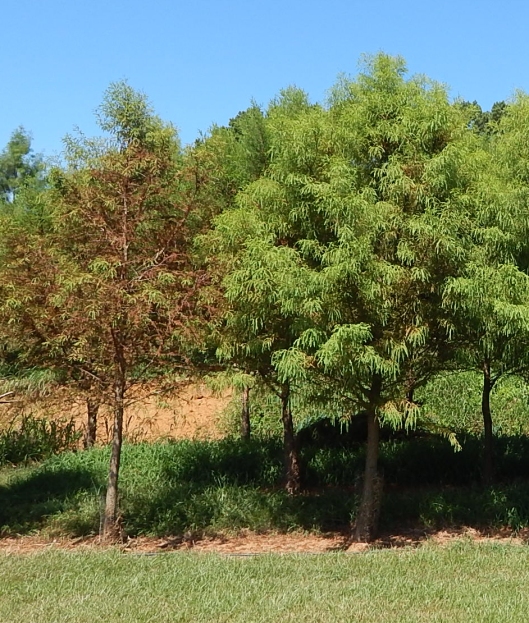
‘LaNana’ showing good resistance to leaf blight at SFA Gardens

A trunk pruned ‘LaNana’ (AKA T406) is very clean at Cypress, Texas (Laurence Truett image)
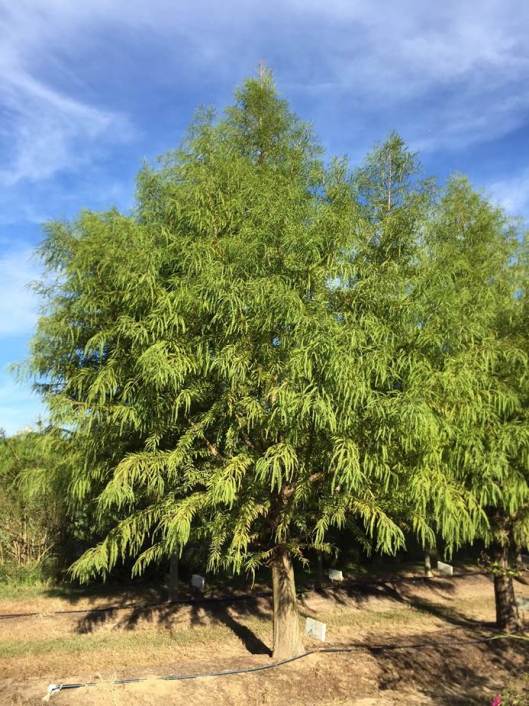
Unpruned ‘LaNana’ at the University of Arkansas, image by Jim Robbins
Propagation: Almost all our trees have been produced by cutting propagation. Cut back trees produce strong shoots that root easy. We’ve found that June cuttings treated with 2500 to 5000 PPM K-IBA can root at high percentages in 12 weeks. Moved from the mist and lightly fertilized, they can be potted into larger containers their first winter.
Conclusions: We have produced thousands of the clones and made distributions to botanical gardens, public gardens, interested nurseries, and bald cypress enthusiasts across the South. The general consensus is that in the right spot they are terrific trees. With strong alkalinity and salt tolerance, they have a place near the coast line or where soils are less than stellar. They are not to be planted in swamps that are inundated. They love being near water but not under it.. While bald cypress can tolerate that, Montezumas and the hybrids prefer better drained conditions. For the discriminating gardener, nurseryman, or landscaper – the China balds are a good bet. How many trees do we plant that can be here 1000 years from now? When you think of the genes of Mexico and USA being combined in China, with selections made, with the millions planted in China – and now they’re back home in the USA ready to deal with a new world. It’s all about international relations.
Arnold, M. and G. Denny. 2007. Taxonomy and Nomenclature of Baldcypress, Pondcypress, and Montezuma Cypress: One, Two, or Three Species? HortTechnology January-March 2007 vol. 17 no. 1 125-127. Which can be accessed here: http://horttech.ashspublications.org/content/17/1/125.abstract
Robert Adams, Mike Arnold, Andrew King, Geoffrey Denny, David Creech. 2012. Taxodium (Cupressaceae): One, Two or Three Species? Evidence from DNA Sequences and Terpenoids. Phytologia 94 (2): 159 – 168. Which can be accessed here . . . http://www.phytologia.org/uploads/2/3/4/2/23422706/94(2)159-168adamsetal_taxoduim_dna.pdf













